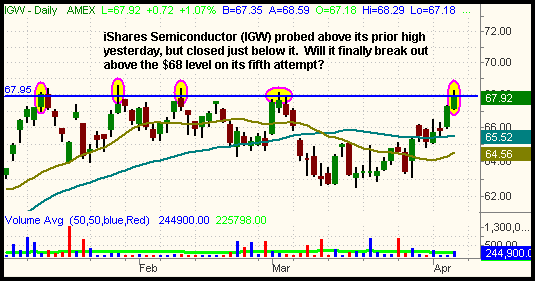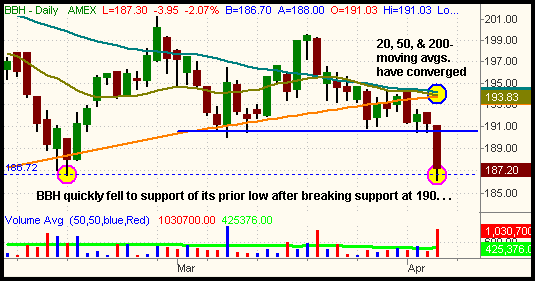It was a roller coaster of a session in the broad market yesterday, as stocks sold off significantly in the morning, rallied in the early afternoon, then drifted lower into the final ninety minutes of trading. The major indices eventually finished with divergent results and near the flat line. The Nasdaq Composite, down 0.5% at its intraday low, concluded with a 0.1% gain, as did the S&P Midcap 400 Index. But both the S&P 500 and Dow Jones Industrial Average showed relative weakness and closed 0.2% lower. The small-cap Russell 2000 was unchanged.
A look "under the hood" at yesterday's volume levels showed a positive overall bias to the session. Total volume in the NYSE declined by 2%, but volume in the Nasdaq was 8% higher than the previous day's level. This was positive considering that the S&P closed lower, but the Nasdaq showed a gain. Healthy markets should have lower turnover on the down days and higher volume on a majority of the up days. The Nasdaq's advance on higher volume gave the index another bullish "accumulation day" yesterday. Market internals confirmed yesterday's divergent price action as well. Advancing volume in the Nasdaq exceeded declining volume by nearly 2 to 1, but the volume ratio was marginally negative in the NYSE.
In yesterday's Wagner Daily, we mentioned that the Semiconductor Index ($SOX) was likely to break out above its 50-day moving average, while the Biotech Index ($BTK) was poised to fall below a major support level. To our satisfaction, that is exactly what happened yesterday. Of the major industry sectors we follow on a daily basis, the $SOX tied with the Gold Index ($GOX) as the top performing sector yesterday. Both industry indexes rallied 1.3%, causing the $SOX to close above its 50-day moving average. Conversely, the worst performing sector yesterday was the $BTK index, which fell 2.3% and broke support of its one-year weekly uptrend line.
The strength in the chip stocks caused our long setup in the iShares Semiconductor (IGW) to trade through its trigger price for buy entry yesterday. Going into the session, our plan was to buy IGW on a rally above its prior high from March 2. IGW traded above that March 2 high on an intraday basis, but unfortunately closed three cents below the 52-week closing high that was set on January 11. Nevertheless, we like the odds of IGW breaking out to new highs from here because the ETF is showing good relative strength to the actual $SOX index. This also marks the fifth attempt of IGW breaking out of its range and each subsequent attempt increases the odds of an eventual breakout. As the daily chart below illustrates, IGW should "make it or break it" within the next few days. We are prepared to tighten our stop quickly if the breakout fails:

The other highlight of yesterday's ETF action was the major weakness in the Biotech HOLDR (BBH), which plummeted after failing to hold support at the 190 level. As subscribers may recall, we sold short BBH on April 3, at a price of 192.51, when it closed below its 200-day moving average. Our initial target was a test of the February 13 low, around the 187 area, which was achieved yesterday. Notice how quickly BBH dropped to support of its prior low after it fell below horizontal price support at 190:

We covered two-thirds of our short position for more than a 5-point gain when BBH hit its initial profit target yesterday, but we are trailing a stop on the remaining shares in order to maximize our profit. If BBH fails to hold at its February 13 low, the next major area of price support is just below the 181 level.
The major divergence between the Semis and Biotechs yesterday was a prime example of why we have been focusing on trading specific industry sector ETFs instead of the broad-based ones. Being long the Nasdaq 100 Index (QQQQ) would have resulted in a 0.4% gain yesterday, but the profits were much larger if you were long any of the Semiconductor ETFs and/or short the Biotech ETFs. But more important than the greater profit potential from trading sector ETFs is the reduced risk of getting stopped out from choppy and divergent broad market conditions. Throughout the past month, attempting to ride a trend in SPY or most of the other broad-based ETFs would have only resulted in frustration. Until the major indices make a convincing move in either direction, our focus will remain on the specific industry sector ETFs that are showing relative strength or weakness to the broad market.
Deron Wagner is the Founder and Head Trader of both Morpheus Capital LP, a U.S. hedge fund, and Morpheus Trading Group, a trader education firm launched in 2001 that provides daily technical analysis of the leading ETFs and stocks. For a free trial to the full version of The Wagner Daily or to learn about Wagner's other services, visit MorpheusTrading.com or send an e-mail to deron@morpheustrading.com.